Car-Following Strategy Involving Stabilizing Traffic Flow with Connected Automated Vehicles to Reduce Particulate Matter (PM) Emissions in Rainy Weather
Abstract
1. Introduction
2. Literature Review
2.1. Car-Following Behavior in Adverse Weather
2.2. Applications of CAVs in Reducing Pollutant Emissions
3. Characteristic Analysis of PM Emissions in Rainy Weather
3.1. Car-Following Model of Traditional Vehicles in Rainy Weather
3.2. Simulation Experiments Based on Calibrated Car-Following Model
3.2.1. Simulation Scenarios
3.2.2. PM Emission Model
3.3. Characteristic Results of PM Emissions
4. Car-Following Strategy for CAVs to Reduce PM Emissions
4.1. Stabilizing the Traffic Flow with CAVs
4.2. Validating the Effectiveness of the Proposed Strategy
4.2.1. Effectiveness for Smoothing Speed Fluctuations
4.2.2. Effectiveness for Reducing PM Emissions
5. Discussion
6. Conclusions
Author Contributions
Funding
Institutional Review Board Statement
Informed Consent Statement
Data Availability Statement
Conflicts of Interest
References
- Long, Y.; Huang, D.; Lei, T.; Zhang, H.; Wang, D.; Yoshida, Y. Spatiotemporal variation and determinants of carbon emissions generated by household private car. Transp. Res. Part D Transp. Environ. 2020, 87, 102490. [Google Scholar] [CrossRef]
- Silva, E.F.F.; de Melo, W.C.; Brasil, A.C. A submodel as a plug-in for the assessment of energy consumption and CO2 emissions in urban mobility plans. Sustainability 2023, 15, 16237. [Google Scholar] [CrossRef]
- Bisignano, A.; Carotenuto, F.; Zaldei, A.; Giovannini, L. Field calibration of a low-cost sensors network to assess traffic-related air pollution along the Brenner highway. Atmos. Environ. 2022, 275, 119008. [Google Scholar] [CrossRef]
- Jia, X.; Qin, X.; Zhu, J.; Xiao, Z.; Guo, W. Carbon emission pattern of driving car on vertical curves of highway. Sustainability 2023, 15, 6460. [Google Scholar] [CrossRef]
- Xu, H.; Cao, S.; Xu, X. The development of highway infrastructure and CO2 emissions: The mediating role of agglomeration. J. Clean. Prod. 2022, 337, 130501. [Google Scholar] [CrossRef]
- Cavallaro, F.; Nocera, S. Are transport policies and economic appraisal aligned in evaluating road externalities? Transp. Res. Part D Transp. Environ. 2022, 106, 103266. [Google Scholar] [CrossRef]
- Lee, W.S.; Tran, T.M.; Yu, L.B. Green infrastructure and air pollution: Evidence from highways connecting two megacities in China. J. Environ. Econ. Manag. 2023, 122, 102884. [Google Scholar] [CrossRef]
- Zeng, C.; Chai, B.; Stringer, L.C.; Li, Y.; Wang, Z.; Deng, X.; Ma, B.; Ren, J. Land-based transportation influences carbon emission in urbanized China: A regional spatial spillover perspective. Sustain. Cities Soc. 2024, 100, 105008. [Google Scholar] [CrossRef]
- Gemma, A.; Giannattasio, O.; Mannini, L. Motorway traffic emissions estimation through stochastic fundamental diagram. Sustainability 2023, 15, 9871. [Google Scholar] [CrossRef]
- Hassan, H.M.; Abdel-Aty, M.A. Analysis of drivers’ behavior under reduced visibility conditions using a structural equation modeling approach. Transp. Res. Part F Traffic Psychol. Behav. 2011, 14, 614–625. [Google Scholar] [CrossRef]
- Hamdar, S.H.; Qin, L.; Talebpour, A. Weather and road geometry impact on longitudinal driving behavior: Exploratory analysis using an empirically supported acceleration modeling framework. Transp. Res. Part C Emerg. Technol. 2016, 67, 193–213. [Google Scholar] [CrossRef]
- Ahmed, M.M.; Ghasemzadeh, A. The impacts of heavy rain on speed and headway Behaviors: An investigation using the SHRP2 naturalistic driving study data. Transp. Res. Part C Emerg. Technol. 2018, 91, 371–384. [Google Scholar] [CrossRef]
- Yeo, J.; Lee, J.; Jang, K. The effects of rainfall on driving behaviors based on driving volatility. Int. J. Sustain. Transp. 2021, 15, 435–443. [Google Scholar] [CrossRef]
- Jiang, R.; Jin, C.J.; Zhang, H.M.; Huang, Y.X.; Tian, J.F.; Wang, W.; Hu, M.-B.; Wang, H.; Jia, B. Experimental and empirical investigations of traffic flow instability. Transp. Res. Part C Emerg. Technol. 2018, 94, 83–98. [Google Scholar] [CrossRef]
- Han, J.; Wang, X.; Shi, H.; Wang, B.; Wang, G.; Chen, L.; Wang, Q. Research on the impacts of vehicle type on car-following behavior, fuel consumption and exhaust emission in the V2X environment. Sustainability 2022, 14, 15231. [Google Scholar] [CrossRef]
- Barth, M.; Boriboonsomsin, K. Real-world carbon dioxide impacts of traffic congestion. Transp. Res. Rec. 2008, 2058, 163–171. [Google Scholar] [CrossRef]
- Song, G.; Yu, L.; Xu, L. Comparative analysis of car-following models for emissions estimation. Transp. Res. Rec. 2013, 2341, 12–22. [Google Scholar] [CrossRef]
- Li, Y.; Zheng, J.; Li, Z.; Yuan, L.; Yang, Y.; Li, F. Re-estimating CO2 emission factors for gasoline passenger cars adding driving behaviour characteristics: A case study of Beijing. Energy Policy 2017, 102, 353–361. [Google Scholar] [CrossRef]
- Wang, J.; Rakha, H.A.; Fadhloun, K. Validation of the Rakha-Pasumarthy-Adjerid car-following model for vehicle fuel consumption and emission estimation applications. Transp. Res. Part D Transp. Environ. 2017, 55, 246–261. [Google Scholar] [CrossRef]
- Liu, C.; Susilo, Y.O.; Karlström, A. Estimating changes in transport CO2 emissions due to changes in weather and climate in Sweden. Transp. Res. Part D Transp. Environ. 2016, 49, 172–187. [Google Scholar] [CrossRef]
- Bandeira, J.M.; Macedo, E.; Fernandes, P.; Rodrigues, M.; Andrade, M.; Coelho, M.C. Potential pollutant emission effects of connected and automated vehicles in a mixed traffic flow context for different road types. IEEE Open J. Intell. Transp. Syst. 2021, 2, 364–383. [Google Scholar] [CrossRef]
- Pribyl, O.; Blokpoel, R.; Matowicki, M. Addressing EU climate targets: Reducing CO2 emissions using cooperative and automated vehicles. Transp. Res. Part D Transp. Environ. 2020, 86, 102437. [Google Scholar] [CrossRef]
- Samimi Abianeh, A.; Burris, M.; Talebpour, A.; Sinha, K. The impacts of connected vehicle technology on network-wide traffic operation and fuel consumption under various incident scenarios. Transp. Plan. Technol. 2020, 43, 293–312. [Google Scholar] [CrossRef]
- Wang, Z.; Xu, L.; Ma, J. Carbon dioxide emission reduction-oriented optimal control of traffic signals in mixed traffic flow based on deep reinforcement learning. Sustainability 2023, 15, 16564. [Google Scholar] [CrossRef]
- Wang, J.; Yu, H.; Chen, S.; Ye, Z.; Ren, Y. Heterogeneous traffic flow signal control and CAV trajectory optimization based on pre-signal lights and dedicated CAV lanes. Sustainability 2023, 15, 15295. [Google Scholar] [CrossRef]
- Bai, Z.; Hao, P.; Shangguan, W.; Cai, B.; Barth, M.J. Hybrid reinforcement learning-based eco-driving strategy for connected and automated vehicles at signalized intersections. IEEE Trans. Intell. Transp. Syst. 2022, 23, 15850–15863. [Google Scholar] [CrossRef]
- He, X.; Wu, X. Eco-driving advisory strategies for a platoon of mixed gasoline and electric vehicles in a connected vehicle system. Transp. Res. Part D Transp. Environ. 2018, 63, 907–922. [Google Scholar] [CrossRef]
- Ghiasi, A.; Li, X.; Ma, J. A mixed traffic speed harmonization model with connected autonomous vehicles. Transp. Res. Part C Emerg. Technol. 2019, 104, 210–233. [Google Scholar] [CrossRef]
- Picone, M.; Carteni, A. Users’ propensity to use self-driving systems of SAE automation level 1 and 2 cars: Results of an Italian survey. WSEAS Trans. Environ. Dev. 2023, 19, 479–488. [Google Scholar] [CrossRef]
- Cartenì, A. The acceptability value of autonomous vehicles: A quantitative analysis of the willingness to pay for shared autonomous vehicles (SAVs) mobility services. Transp. Res. Interdiscip. Perspect. 2020, 8, 100224. [Google Scholar] [CrossRef]
- Cascetta, E.; Carteni, A.; Di Francesco, L. Do autonomous vehicles drive like humans? a turing approach and an application to SAE automation level 2 cars. Transp. Res. Part C Emerg. Technol. 2022, 134, 103499. [Google Scholar] [CrossRef]
- Chikaraishi, M.; Khan, D.; Yasuda, B.; Fujiwara, A. Risk perception and social acceptability of autonomous vehicles: A case study in Hiroshima, Japan. Transp. Policy 2020, 98, 105–115. [Google Scholar] [CrossRef]
- Gao, K.; Tu, H.; Sun, L.; Sze, N.N.; Song, Z.; Shi, H. Impacts of reduced visibility under hazy weather condition on collision risk and car-following behavior: Implications for traffic control and management. Int. J. Sustain. Transp. 2020, 14, 635–642. [Google Scholar] [CrossRef]
- Huang, Y.; Yan, X.; Li, X.; Yang, J. Using a multi-user driving simulator system to explore the patterns of vehicle fleet rear-end collisions occurrence under different foggy conditions and speed limits. Transp. Res. Part F Traffic Psychol. Behav. 2020, 74, 161–172. [Google Scholar] [CrossRef]
- Huang, Y.; Yan, X.; Li, X.; Duan, K.; Rakotonirainy, A.; Gao, Z. Improving car-following model to capture unobserved driver heterogeneity and following distance features in fog condition. Transp. A Transp. Sci. 2022, 10, 2048917. [Google Scholar] [CrossRef]
- Hammit, B.E.; Ghasemzadeh, A.; James, R.M.; Ahmed, M.M.; Young, R.K. Evaluation of weather-related freeway car-following behavior using the SHRP2 naturalistic driving study database. Transp. Res. Part F Traffic Psychol. Behav. 2018, 59, 244–259. [Google Scholar] [CrossRef]
- Rahman, A.; Lownes, N.E. Analysis of rainfall impacts on platooned vehicle spacing and speed. Transp. Res. Part F Traffic Psychol. Behav. 2012, 15, 395–403. [Google Scholar] [CrossRef]
- FHWA Road Weather Management Program. How Do Weather Events Impact Roads? 2009. Available online: http://ops.fhwa.dot.gov/Weather/q1_roadimpact.htm (accessed on 27 February 2024).
- Ibrahim, A.T.; Hall, F.L. Effect of adverse weather conditions on speed-flow-occupancy relationships. Transp. Res. Rec. J. Transp. Res. Board 1994, 1457, 184–191. [Google Scholar]
- Bikmetov, R.; Lim, C.; Bikmetova, N.; Kazi, K.; Raja, M.Y.A. Simulation-based analytical framework for M2M autonomous charging infrastructure. IEEE Trans. Eng. Manag. 2021, 70, 4133–4143. [Google Scholar] [CrossRef]
- Noh, B.; Yeo, H. A novel method of predictive collision risk area estimation for proactive pedestrian accident prevention system in urban surveillance infrastructure. Transp. Res. Part C Emerg. Technol. 2022, 137, 103570. [Google Scholar] [CrossRef]
- Yu, F.; Xiu, X.; Li, Y. A survey on deep transfer learning and beyond. Mathematics 2022, 10, 3619. [Google Scholar] [CrossRef]
- Zhai, C.; Xu, Y.; Li, K.; Zhang, R.; Peng, T.; Zong, C.; Xu, H. Periodic intermittent cruise control: An innovative approach for reducing fuel consumption and exhaust emissions in road traffic systems. Process Saf. Environ. Prot. 2023, 177, 1197–1210. [Google Scholar] [CrossRef]
- Wang, Z.D.; Chen, X.Q.; Ouyang, Y.F.; Li, M. Emission mitigation via longitudinal control of intelligent vehicles in a congested platoon. Comput.-Aided Civ. Infrastruct. Eng. 2015, 30, 490–506. [Google Scholar] [CrossRef]
- Makridis, M.; Mattas, K.; Mogno, C.; Ciuffo, B.; Fontaras, G. The impact of automation and connectivity on traffic flow and CO2 emissions. A detailed microsimulation study. Atmos. Environ. 2020, 226, 117399. [Google Scholar] [CrossRef]
- Aljamal, M.A.; Abdelghaffar, H.M.; Rakha, H.A. Estimation of traffic stream density using connected vehicle data: Linear and nonlinear filtering approaches. Sensors 2020, 20, 4066. [Google Scholar] [CrossRef] [PubMed]
- Kopelias, P.; Demiridi, E.; Vogiatzis, K.; Skabardonis, A.; Zafiropoulou, V. Connected & autonomous vehicles–Environmental impacts—A review. Sci. Total Environ. 2020, 712, 135237. [Google Scholar] [PubMed]
- Huang, L.; Zhai, C.; Wang, H.; Zhang, R.; Qiu, Z.; Wu, J. Cooperative adaptive cruise control and exhaust emission evaluation under heterogeneous connected vehicle network environment in urban city. J. Environ. Manag. 2020, 256, 109975. [Google Scholar] [CrossRef] [PubMed]
- Chandra, S.; Camal, F. A simulation-based evaluation of connected vehicle technology for emissions and fuel consumption. Procedia Eng. 2016, 145, 296–303. [Google Scholar] [CrossRef]
- Obaid, L.; Alattieh, S.A.; Abdallah, M.; Hamad, K. Environmental impacts of the transition to automated vehicles: A life cycle perspective. Sustain. Mater. Technol. 2023, 38, e00725. [Google Scholar] [CrossRef]
- Xiong, X.; Sha, J.; Jin, L. Optimizing coordinated vehicle platooning: An analytical approach based on stochastic dynamic programming. Transp. Res. Part B Methodol. 2021, 150, 482–502. [Google Scholar] [CrossRef]
- Fakhfakh, S.; Jankovic, M.; Hein, A.M.; Chazal, Y. Early stakeholder modeling and analysis: New mobility services (Product Service Systems of Systems). Syst. Eng. 2023, 1–17. [Google Scholar] [CrossRef]
- Jiang, L.; Chen, H.; Chen, Z. City readiness for connected and autonomous vehicles: A multi-stakeholder and multi-criteria analysis through analytic hierarchy process. Transp. Policy 2022, 128, 13–24. [Google Scholar] [CrossRef]
- Feys, M.; Rombaut, E.; Macharis, C.; Vanhaverbeke, L. Understanding stakeholders’ evaluation of autonomous vehicle services complementing public transport in an urban context. In Proceedings of the 2020 Forum on Integrated and Sustainable Transportation Systems (FISTS), Delft, The Netherlands, 3–5 November 2020; IEEE: Piscataway, NJ, USA; pp. 341–346. [Google Scholar]
- Graf, A.; Sonnberger, M. Responsibility, rationality, and acceptance: How future users of autonomous driving are constructed in stakeholders’ sociotechnical imaginaries. Public Underst. Sci. 2020, 29, 61–75. [Google Scholar] [CrossRef] [PubMed]
- Kacperski, C.; Vogel, T.; Kutzner, F. Ambivalence in stakeholders’ views on connected and autonomous vehicles. In International Conference on Human Computer Interaction; Springer: Cham, Switzerland, 2020; pp. 46–57. [Google Scholar]
- Shibayama, T.; Pungillo, G.; Lemmerer, H.; Nocera, S. Stakeholder involvement in decision-making process: A test assessment towards transition to autonomous vehicles. Transp. Res. Procedia 2020, 48, 2550–2568. [Google Scholar] [CrossRef]
- Shang, W.L.; Zhang, M.; Wu, G.; Yang, L.; Fang, S.; Ochieng, W. Estimation of traffic energy consumption based on macro-micro modelling with sparse data from Connected and Automated Vehicles. Appl. Energy 2023, 351, 121916. [Google Scholar] [CrossRef]
- Zhou, B.; He, L.; Zhang, S.; Wang, R.; Zhang, L.; Li, M.; Liu, Y.; Zhang, S.; Wu, Y.; Hao, J. Variability of fuel consumption and CO2 emissions of a gasoline passenger car under multiple in-laboratory and on-road testing conditions. J. Environ. Sci. 2023, 125, 266–276. [Google Scholar] [CrossRef]
- Wang, X.; Zhang, J.; Li, H.; He, Z. A mixed traffic car-following behavior model. Phys. A Stat. Mech. Its Appl. 2023, 632, 129299. [Google Scholar] [CrossRef]
- Jin, S.; Sun, D.H.; Zhao, M.; Li, Y.; Chen, J. Modeling and stability analysis of mixed traffic with conventional and connected automated vehicles from cyber physical perspective. Phys. A Stat. Mech. Its Appl. 2020, 551, 124217. [Google Scholar] [CrossRef]
- Fernandes, P.; Ferreira, E.; Amorim, P.; Coelho, M.C. Comparing different approaches for estimating tailpipe emissions in passenger cars. Transp. Res. Procedia 2022, 62, 509–516. [Google Scholar] [CrossRef]
- Qin, Y.; Wang, H.; Ran, B. Impacts of cooperative adaptive cruise control platoons on emissions under traffic oscillation. J. Intell. Transp. Syst. 2021, 25, 376–383. [Google Scholar] [CrossRef]
- James, R.M.; Hammit, B.E.; Boyles, S.D. Methods to obtain representative car-following model parameters from trajectory-level data for use in microsimulation. Transp. Res. Rec. 2019, 2673, 62–73. [Google Scholar] [CrossRef]
- Díaz, S.; Mock, P.; Bernard, Y.; Bieker, G.; Pniewska, I.; Ragon, P.; Rodríguez, F.; Tietge, U.; Wappelhorst, S. European Vehicle Market Statistics 2020/21; International Council on Clean Transportation: Washington, DC, USA, 2020. [Google Scholar]
- Tzamkiozis, T.; Ntziachristos, L.; Samaras, Z. Diesel passenger car PM emissions: From Euro 1 to Euro 4 with particle filter. Atmos. Environ. 2010, 44, 909–916. [Google Scholar] [CrossRef]
- Cen, X.; Lo, H.K.; Li, L. A framework for estimating traffic emissions: The development of passenger car emission unit. Transp. Res. Part D Transp. Environ. 2016, 44, 78–92. [Google Scholar] [CrossRef]
- Kuppili, S.K.; Alshetty, V.D.; Diya, M.; Nagendra, S.S.; Ramadurai, G.; Ramesh, A.; Gulia, S.; Namdeo, A.; Maji, K.; Bell, M.; et al. Characteristics of real-world gaseous exhaust emissions from cars in heterogeneous traffic conditions. Transp. Res. Part D Transp. Environ. 2021, 95, 102855. [Google Scholar] [CrossRef]
- Chandrashekar, C.; Chatterjee, P.; Pawar, D.S. Estimation of CO2 and CO emissions from auto-rickshaws in Indian heterogeneous traffic. Transp. Res. Part D Transp. Environ. 2022, 104, 103202. [Google Scholar] [CrossRef]
- Smit, R.; Ntziachristos, L.; Boulter, P. Validation of road vehicle and traffic emission models–a review and meta-analysis. Atmos. Environ. 2010, 44, 2943–2953. [Google Scholar] [CrossRef]
- Grote, M.; Williams, I.; Preston, J.; Kemp, S. Including congestion effects in urban road traffic CO2 emissions modelling: Do local government authorities have the right options? Transp. Res. Part D Transp. Environ. 2016, 43, 95–106. [Google Scholar] [CrossRef]
- Abou-Senna, H.; Radwan, E.; Westerlund, K.; Cooper, C.D. Using a traffic simulation model (VISSIM) with an emissions model (MOVES) to predict emissions from vehicles on a limited-access highway. J. Air Waste Manag. Assoc. 2013, 63, 819–831. [Google Scholar] [CrossRef]
- Panis, L.I.; Broekx, S.; Liu, R. Modelling instantaneous traffic emission and the influence of traffic speed limits. Sci. Total Environ. 2006, 371, 270–285. [Google Scholar] [CrossRef]
- Forehead, H.; Huynh, N. Review of modelling air pollution from traffic at street-level-The state of the science. Environ. Pollut. 2018, 241, 775–786. [Google Scholar] [CrossRef]
- Bouadi, M.; Jia, B.; Jiang, R.; Li, X.; Gao, Z. Stochastic factors and string stability of traffic flow: Analytical investigation and numerical study based on car-following models. Transp. Res. Part B Methodol. 2022, 165, 96–122. [Google Scholar] [CrossRef]
- Montanino, M.; Punzo, V. On string stability of a mixed and heterogeneous traffic flow: A unifying modelling framework. Transp. Res. Part B Methodol. 2021, 144, 133–154. [Google Scholar] [CrossRef]
- Qin, Y.; Luo, Q.; Wang, H. Stability analysis and connected vehicles management for mixed traffic flow with platoons of connected automated vehicles. Transp. Res. Part C Emerg. Technol. 2023, 157, 104370. [Google Scholar] [CrossRef]
- Wilson, R.E. An analysis of Gipps’s car-following model of highway traffic. IMA J. Appl. Math. 2001, 66, 509–537. [Google Scholar] [CrossRef]
- Wood, J.S.; Zhang, S. Evaluating relationships between perception-reaction times, emergency deceleration rates, and crash outcomes using naturalistic driving data. Transp. Res. Rec. 2020, 2675, 213–223. [Google Scholar] [CrossRef]
- Jia, L.; Cheng, P.; Yu, Y.; Chen, S.H.; Wang, C.X.; He, L.; Nie, H.-T.; Wang, J.-C.; Zhang, J.-C.; Fan, B.-G.; et al. Regeneration mechanism of a novel high-performance biochar mercury adsorbent directionally modified by multimetal multilayer loading. J. Environ. Manag. 2023, 326, 116790. [Google Scholar] [CrossRef]

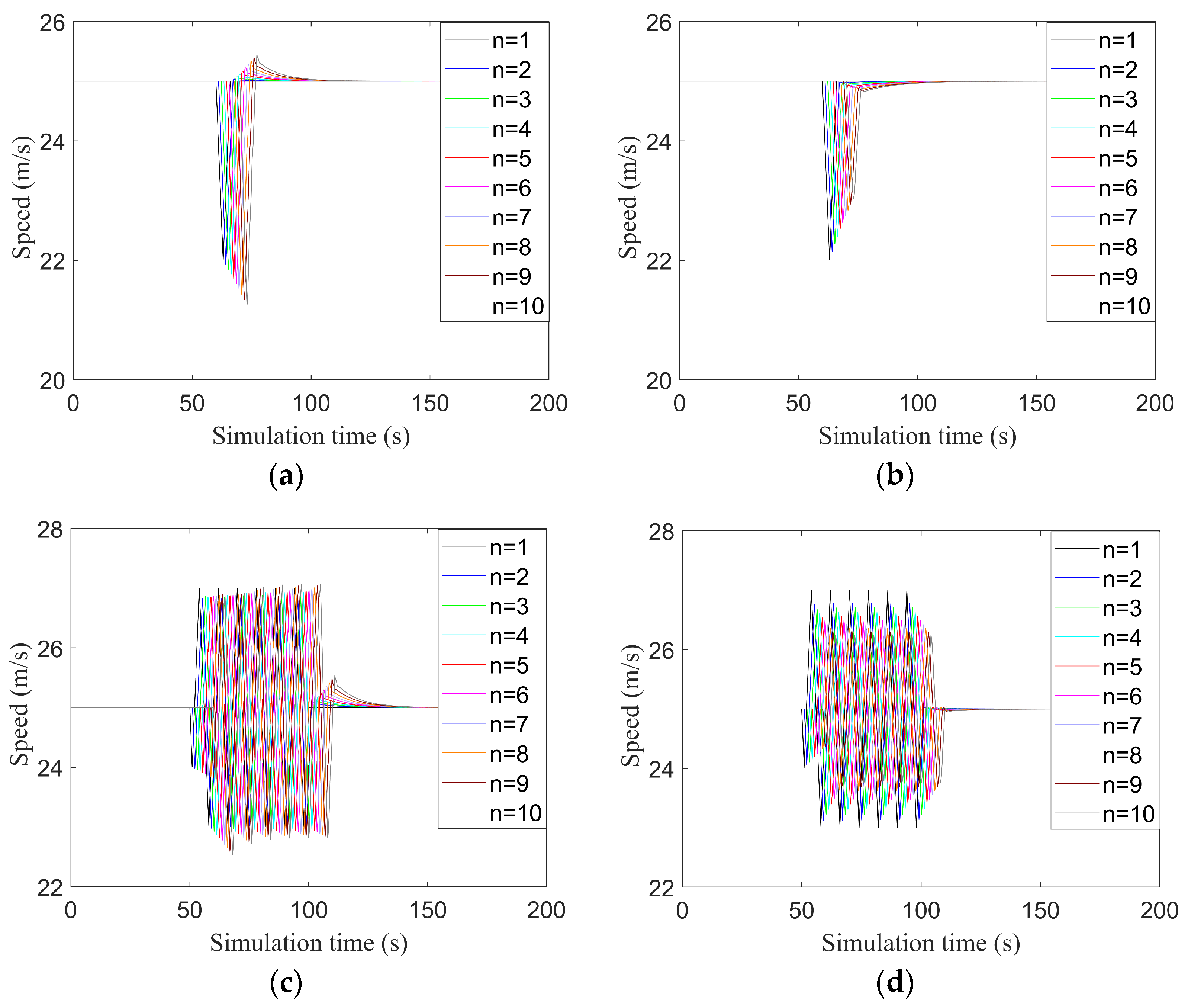
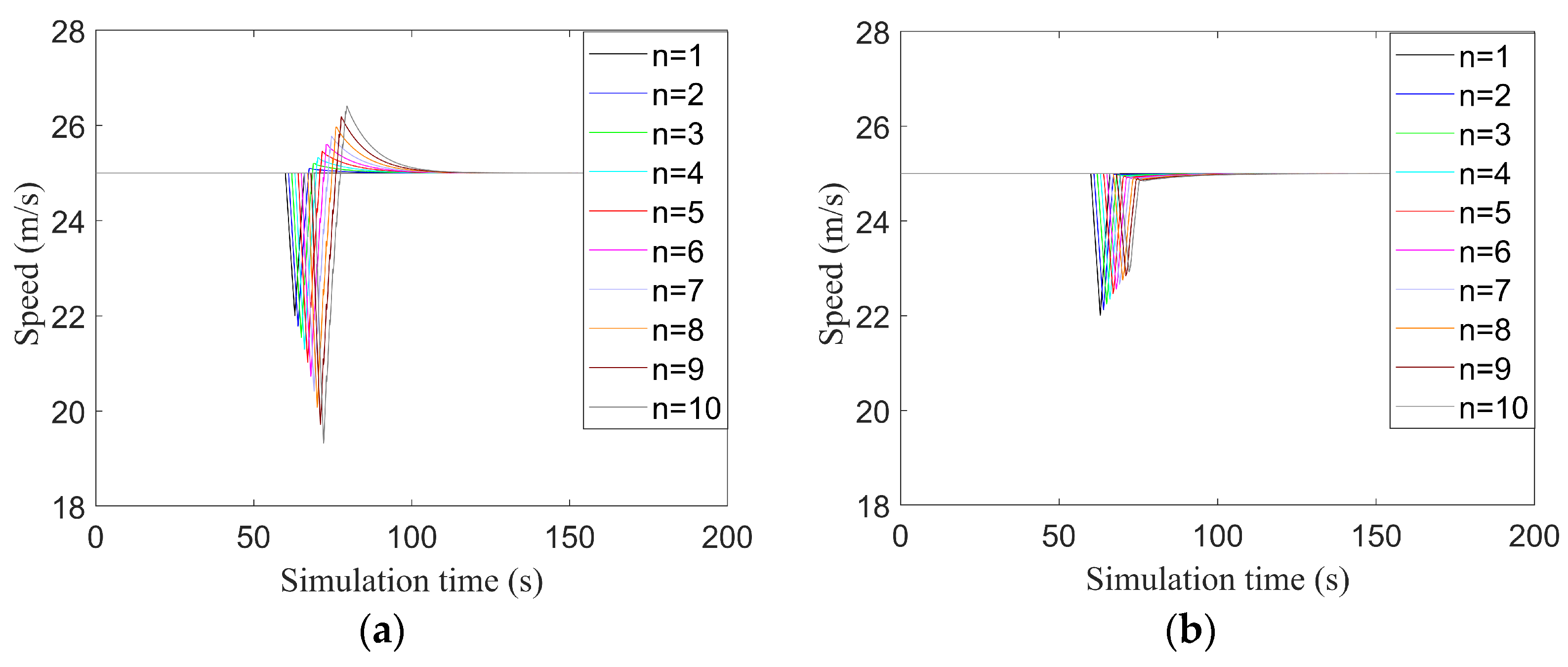
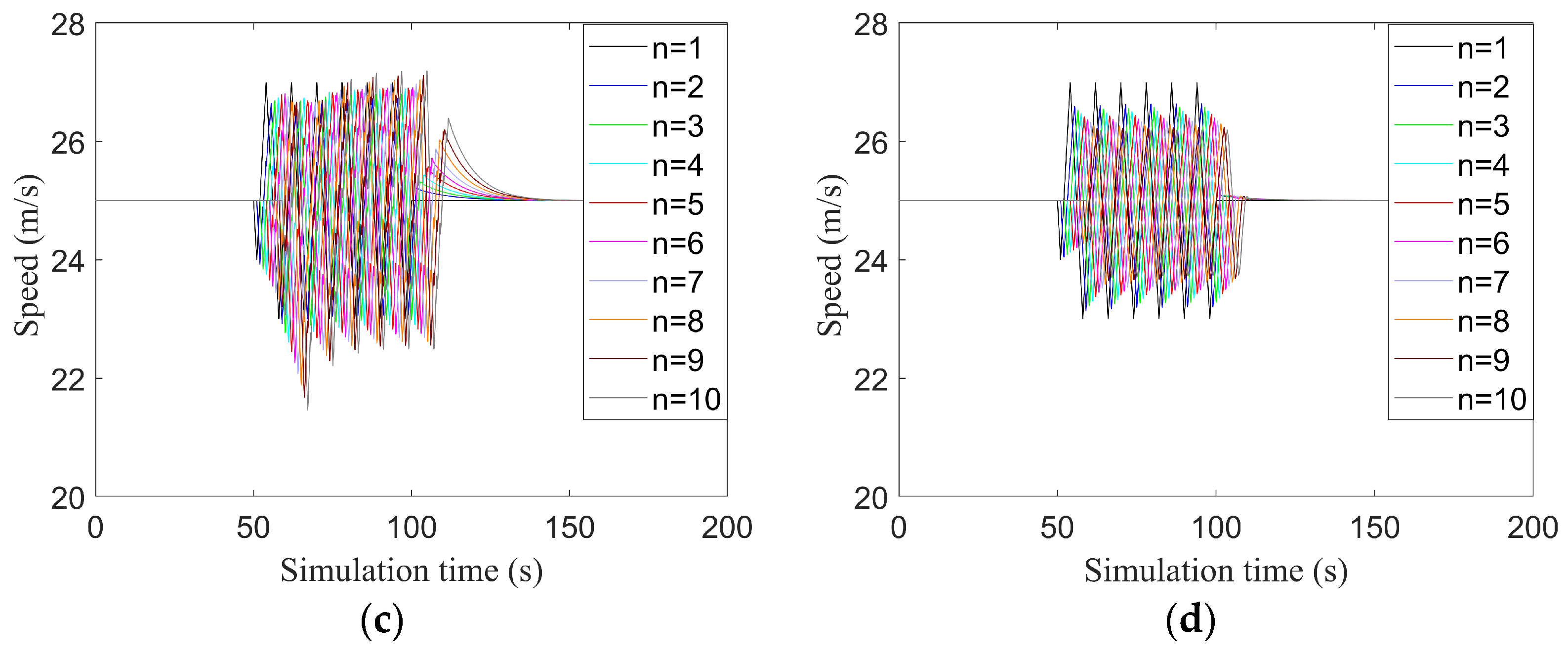
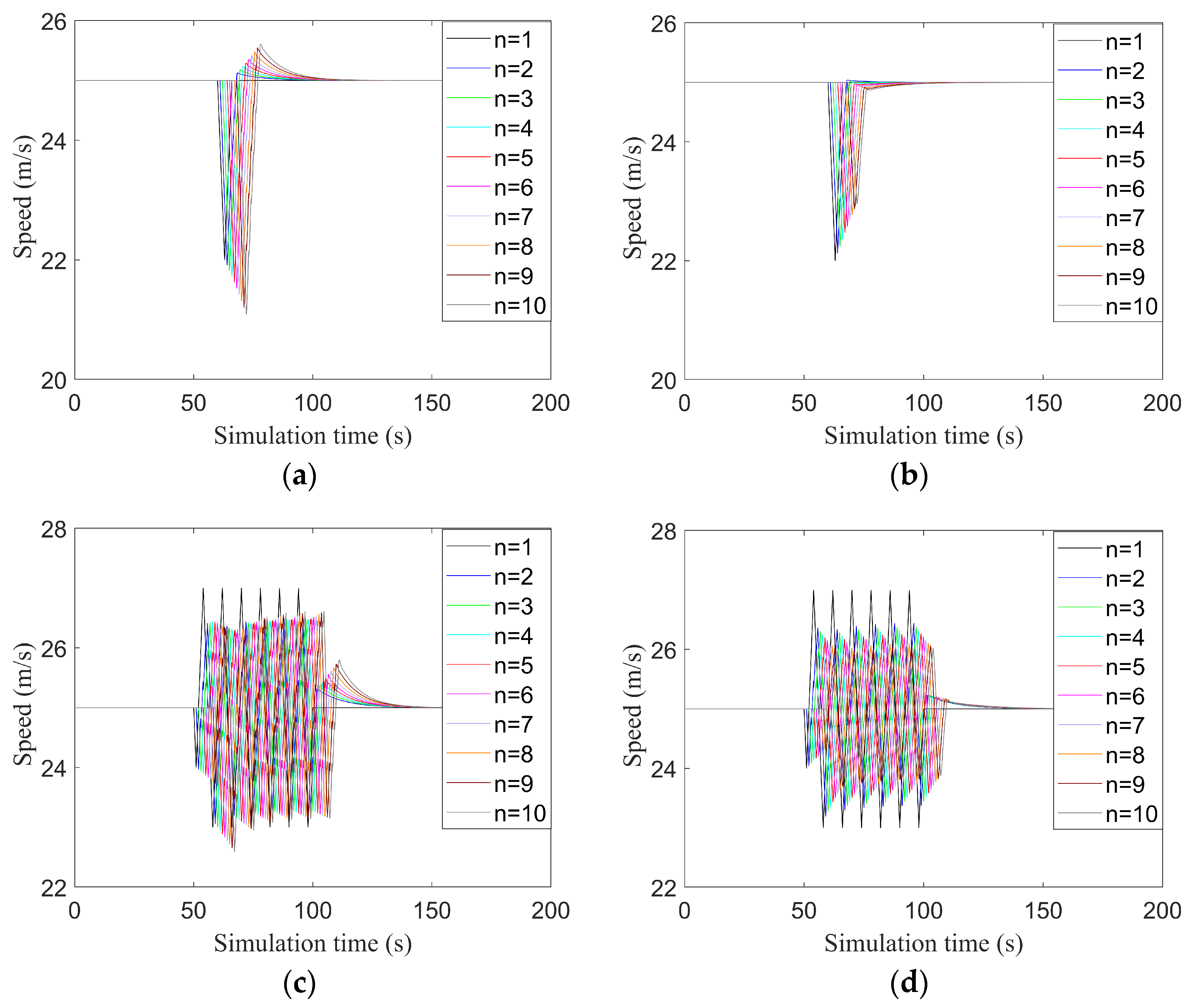
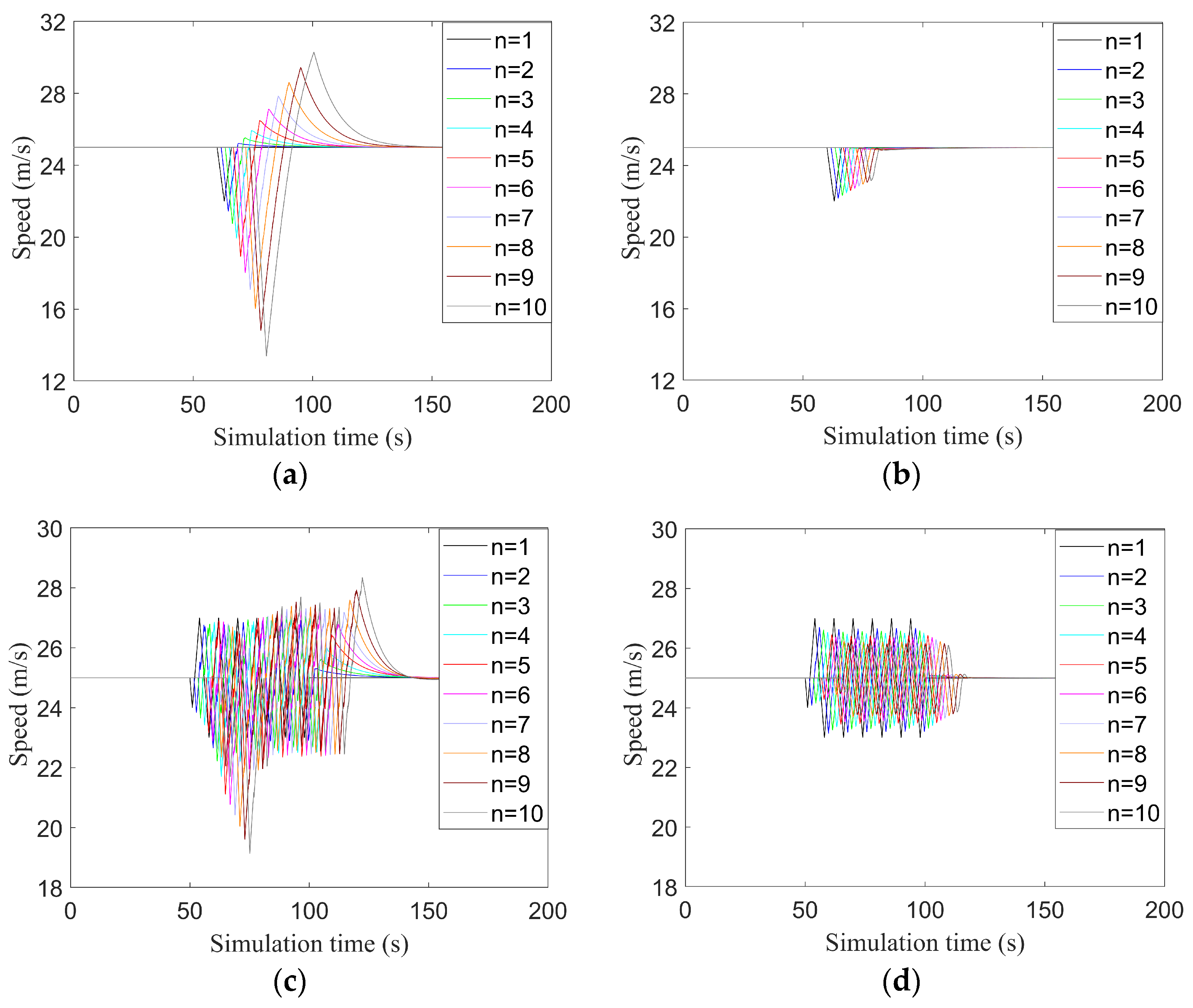
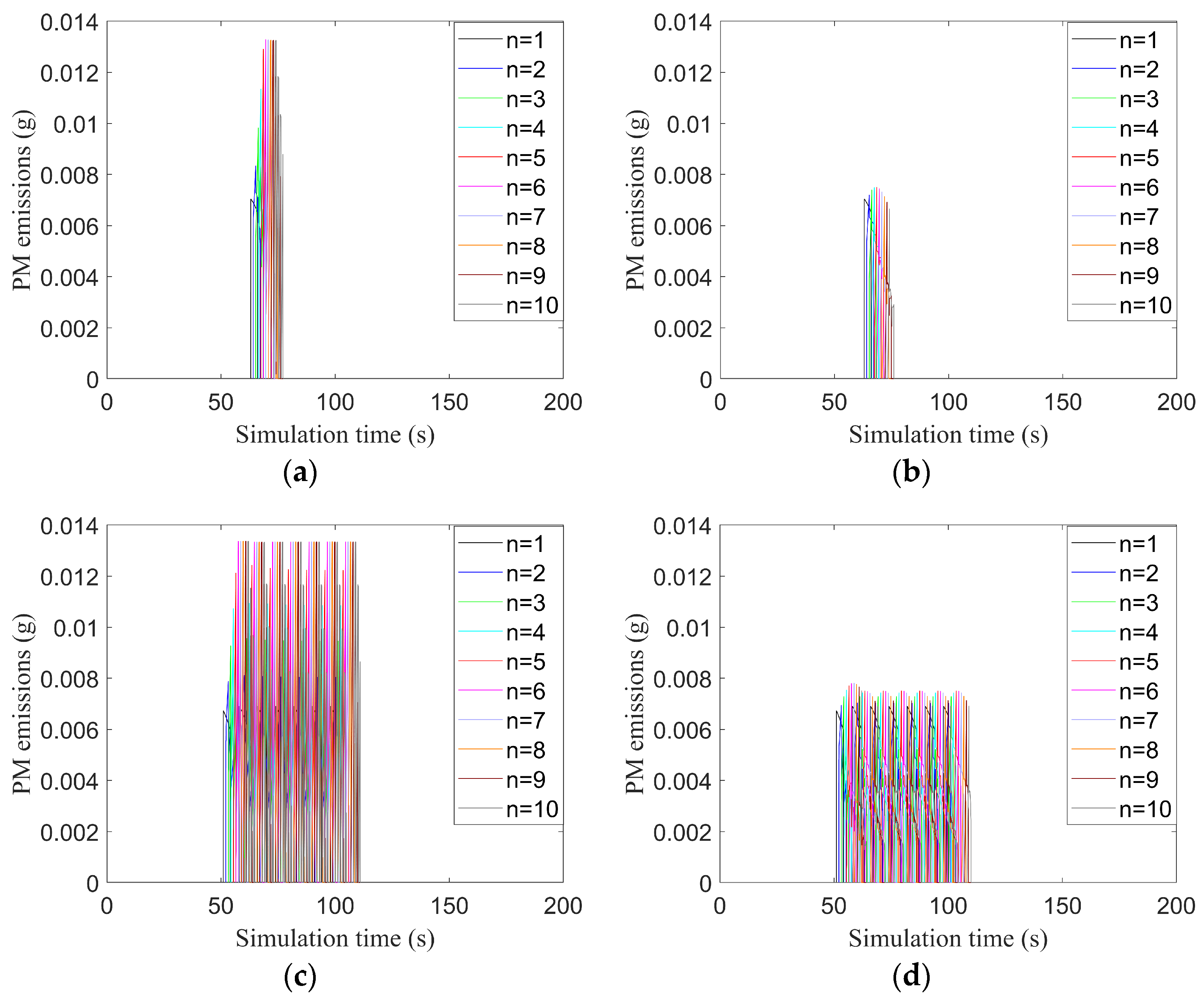


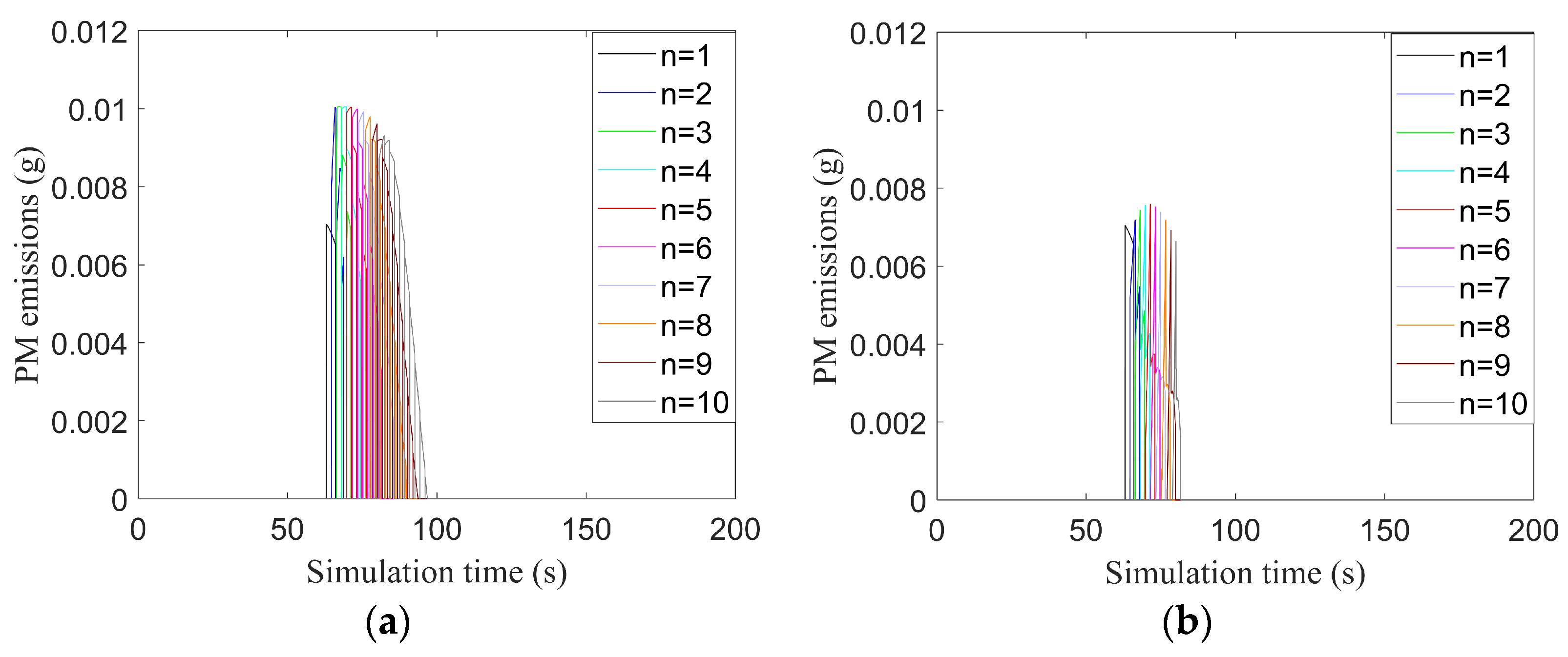
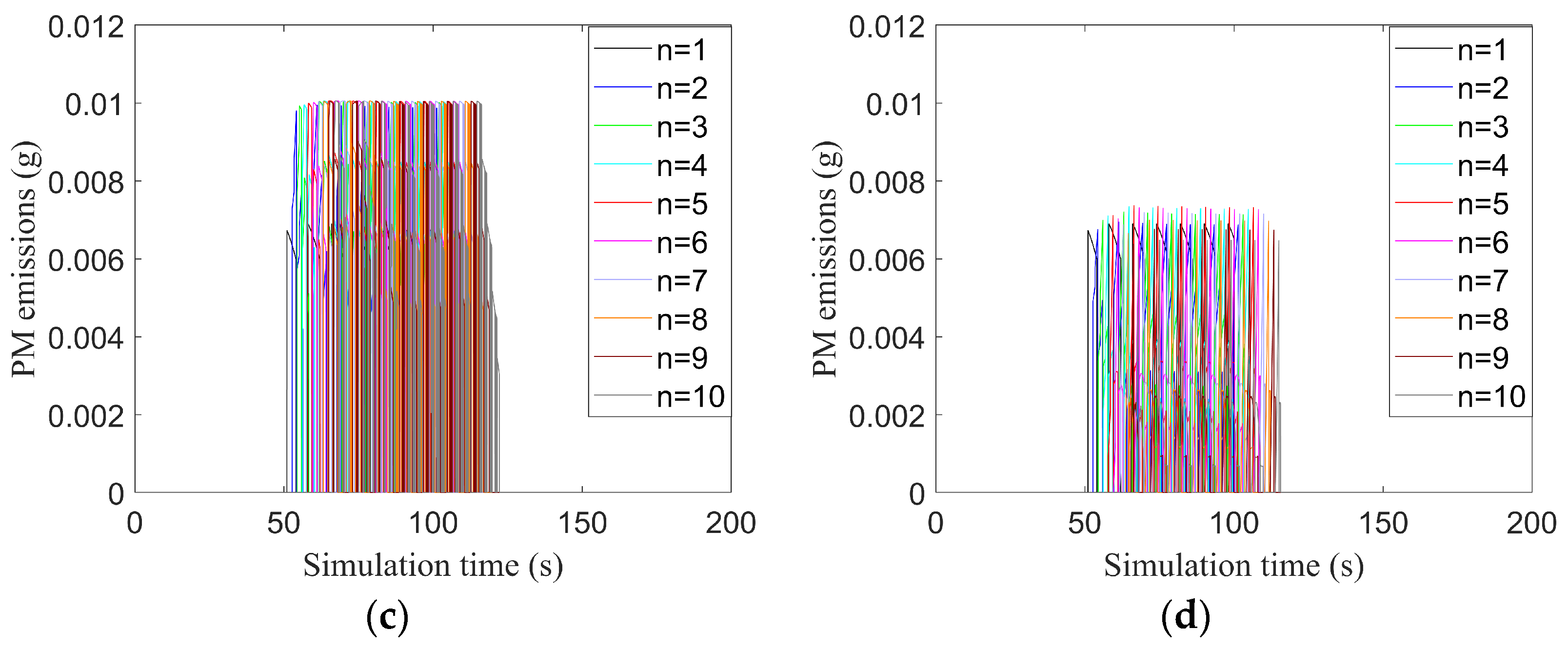
| Literature | Trajectory Data Sources | Weather | Target Emissions |
|---|---|---|---|
| Zong and Yue [23] | Simulation experimental data | Clear weather | CO2 |
| Zhai et al. [43] | Simulation experimental data | Clear weather | CO, HC, NOX |
| Wang et al. [49] | Simulation experimental data | Clear weather | CO2, HC, NOX, VOC |
| Shang et al. [58] | Simulation experimental data | Clear weather | CO2, CO, HC |
| Zhou et al. [59] | Real experimental data | Clear weather | CO2 |
| Wang et al. [60] | Simulation experimental data | Clear weather | CO, HC, NOX |
| Jin et al. [61] | Simulation experimental data | Clear weather | CO2 |
| Fernandes et al. [62] | Real experimental data | Clear weather | CO2, NOX |
| Rain Conditions | vf (m/s) | an (m/s2) | bn (m/s2) | bn−1 (m/s2) | τ (s) | d (m) |
|---|---|---|---|---|---|---|
| Very light rain | 33.2 | 1.6 | −2.5 | −2.3 | 1.1 | 3.1 |
| Light rain | 31.1 | 1.7 | −2.5 | −2.2 | 1.0 | 3.2 |
| Moderate rain | 30.2 | 1.5 | −2.5 | −2.3 | 1.0 | 3.6 |
| Heavy rain | 34.3 | 1.3 | −2.2 | −1.7 | 1.7 | 3.8 |
| Parameters | Values |
|---|---|
| E0 | 0.00 |
| f1 | 0.00 |
| f2 | 3.13 × 10−4 |
| f3 | −1.84 × 10−5 |
| f4 | 0.00 |
| f5 | 7.50 × 10−4 |
| f6 | 3.78 × 10−4 |
| Rain Conditions | Reduction Percentages | ||
|---|---|---|---|
| Scenario 1 | Scenario 2 | Average Reduction | |
| Very light rain | 44.06% | 38.08% | 41.07% |
| Light rain | 62.57% | 56.34% | 59.46% |
| Moderate rain | 51.72% | 47.47% | 49.60% |
| Heavy rain | 78.71% | 64.60% | 71.66% |
Disclaimer/Publisher’s Note: The statements, opinions and data contained in all publications are solely those of the individual author(s) and contributor(s) and not of MDPI and/or the editor(s). MDPI and/or the editor(s) disclaim responsibility for any injury to people or property resulting from any ideas, methods, instructions or products referred to in the content. |
© 2024 by the authors. Licensee MDPI, Basel, Switzerland. This article is an open access article distributed under the terms and conditions of the Creative Commons Attribution (CC BY) license (https://creativecommons.org/licenses/by/4.0/).
Share and Cite
Li, R.; Qin, Y. Car-Following Strategy Involving Stabilizing Traffic Flow with Connected Automated Vehicles to Reduce Particulate Matter (PM) Emissions in Rainy Weather. Sustainability 2024, 16, 2045. https://doi.org/10.3390/su16052045
Li R, Qin Y. Car-Following Strategy Involving Stabilizing Traffic Flow with Connected Automated Vehicles to Reduce Particulate Matter (PM) Emissions in Rainy Weather. Sustainability. 2024; 16(5):2045. https://doi.org/10.3390/su16052045
Chicago/Turabian StyleLi, Renjie, and Yanyan Qin. 2024. "Car-Following Strategy Involving Stabilizing Traffic Flow with Connected Automated Vehicles to Reduce Particulate Matter (PM) Emissions in Rainy Weather" Sustainability 16, no. 5: 2045. https://doi.org/10.3390/su16052045
APA StyleLi, R., & Qin, Y. (2024). Car-Following Strategy Involving Stabilizing Traffic Flow with Connected Automated Vehicles to Reduce Particulate Matter (PM) Emissions in Rainy Weather. Sustainability, 16(5), 2045. https://doi.org/10.3390/su16052045






